Empirical Study on Capital Structure Optimization
VerifiedAdded on 2021/04/26
|18
|3846
|78
AI Summary
This assignment involves an empirical study on the optimization of capital structure for companies. It includes a comprehensive review of various capital structure theories, such as Static Trade-off theory and Pecking order theory, along with a critical analysis of the current situation of capital structure in China. The assignment also provides case studies from Atlan Holdings Bhd., including an examination of their financial statements and debt financing strategies.
Contribute Materials
Your contribution can guide someone’s learning journey. Share your
documents today.

1
Table of Contents
1.0Introduction on the two selected companies........................... 2
2.0Analysis Company A...............................................................5
3.0Analysis of company B........................................................... 8
4.0Evaluation of two companies.........................错错错错错错错错。
5.0references............................................................................... 16
Table of Contents
1.0Introduction on the two selected companies........................... 2
2.0Analysis Company A...............................................................5
3.0Analysis of company B........................................................... 8
4.0Evaluation of two companies.........................错错错错错错错错。
5.0references............................................................................... 16
Secure Best Marks with AI Grader
Need help grading? Try our AI Grader for instant feedback on your assignments.

2
1.0Introduction on the two selected companies.
DATASONIC GROUP BERHAD (" data company ") was incorporated on October
22, 1980. datasonic group berhad was originally called Bumi Packaging & Storage (M)
Sdn Bhd. In its initial phase, the company sold ICT products in the form of computer
forms and credit card printers to financial institutions in Malaysia. Datasonic Smart
solutions, incorporated in Malaysia on 2 April 2004, is a private limited company
providing research and development and technical consulting services to Datasonic
corporation and Datasonic Technologies. Our group using Datasonic intelligent
solution as the main channel to carry out research and development activities of the
smart card operating system solutions and other key ICT development including the
development of centralized and decentralized card issuance systems and solutions,
multi-purpose ID system, integration of front-end and back-end system solutions and
total system based on network solutions to support our group's current and future
business. Datasonic Innovation Sdn Bhd (" Datasonic Innovation "), established on
July 25, 2014, is a subsidiary of Datasonic Group and is engaged in biometric
solutions. datasonic group berhad was acquired by Datasonic Group on July 16,
2014. It is a controlled subsidiary of Datasonic Group and its wholly owned
subsidiary Constant Ahead Sdn Bhd. The main activity of data manufacturing is the
manufacture of electronic integrated circuit CARDS, or smart CARDS and related
products.
1.0Introduction on the two selected companies.
DATASONIC GROUP BERHAD (" data company ") was incorporated on October
22, 1980. datasonic group berhad was originally called Bumi Packaging & Storage (M)
Sdn Bhd. In its initial phase, the company sold ICT products in the form of computer
forms and credit card printers to financial institutions in Malaysia. Datasonic Smart
solutions, incorporated in Malaysia on 2 April 2004, is a private limited company
providing research and development and technical consulting services to Datasonic
corporation and Datasonic Technologies. Our group using Datasonic intelligent
solution as the main channel to carry out research and development activities of the
smart card operating system solutions and other key ICT development including the
development of centralized and decentralized card issuance systems and solutions,
multi-purpose ID system, integration of front-end and back-end system solutions and
total system based on network solutions to support our group's current and future
business. Datasonic Innovation Sdn Bhd (" Datasonic Innovation "), established on
July 25, 2014, is a subsidiary of Datasonic Group and is engaged in biometric
solutions. datasonic group berhad was acquired by Datasonic Group on July 16,
2014. It is a controlled subsidiary of Datasonic Group and its wholly owned
subsidiary Constant Ahead Sdn Bhd. The main activity of data manufacturing is the
manufacture of electronic integrated circuit CARDS, or smart CARDS and related
products.

3
B错 ATLAN HOLDINGS BHD.
Atlan Holdings Limited is a private limited company, established in 1988 and located
at 8 Lebuhraya Kampung Jawa 11900 Bayan Lepas Pulau Pinang. The company was
listed on the second board of the Bursa Securities in 1996 and then moved to the main
market. In 2009, Atlan ’s main business was investment holding, provision of
management, finance, technology and other ancillary services, while its subsidiaries
were engaged in the trading of commodities in real estate investment, hotels, and auto
parts manufacturing.The company type is Manufacturer.
The 4.6 acres of main agreement road Jamp Ampang in the center of Kuala Lumpur is
Menara Atlan, which is an office building, which is the company's reflection on
property investment. Menara Atlan main tenant: Malaysia's biotechnology research
and development, one of Malaysia's major telecommunications service providers and
major real estate developers.
Atlan's subsidiary United Industries Holdings Sdn Bhd is currently one of the market
leaders in manufacturing metal pipes, fuel fillers, fuel tank modules, metal stampings
and accessories. This is the company's manifestation in manufacturing. UI Group is
B错 ATLAN HOLDINGS BHD.
Atlan Holdings Limited is a private limited company, established in 1988 and located
at 8 Lebuhraya Kampung Jawa 11900 Bayan Lepas Pulau Pinang. The company was
listed on the second board of the Bursa Securities in 1996 and then moved to the main
market. In 2009, Atlan ’s main business was investment holding, provision of
management, finance, technology and other ancillary services, while its subsidiaries
were engaged in the trading of commodities in real estate investment, hotels, and auto
parts manufacturing.The company type is Manufacturer.
The 4.6 acres of main agreement road Jamp Ampang in the center of Kuala Lumpur is
Menara Atlan, which is an office building, which is the company's reflection on
property investment. Menara Atlan main tenant: Malaysia's biotechnology research
and development, one of Malaysia's major telecommunications service providers and
major real estate developers.
Atlan's subsidiary United Industries Holdings Sdn Bhd is currently one of the market
leaders in manufacturing metal pipes, fuel fillers, fuel tank modules, metal stampings
and accessories. This is the company's manifestation in manufacturing. UI Group is
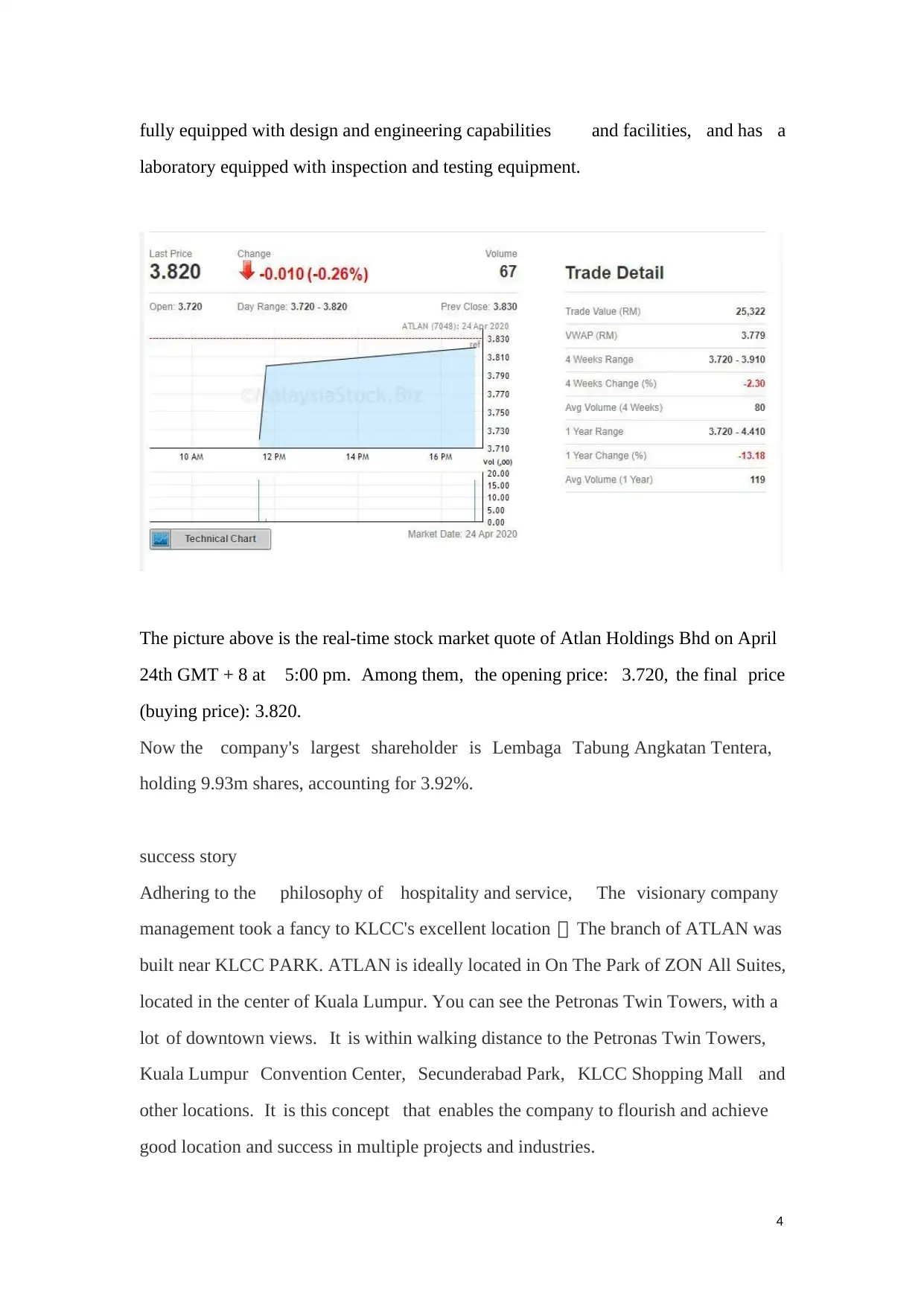
4
fully equipped with design and engineering capabilities and facilities, and has a
laboratory equipped with inspection and testing equipment.
The picture above is the real-time stock market quote of Atlan Holdings Bhd on April
24th GMT + 8 at 5:00 pm. Among them, the opening price: 3.720, the final price
(buying price): 3.820.
Now the company's largest shareholder is Lembaga Tabung Angkatan Tentera,
holding 9.93m shares, accounting for 3.92%.
success story
Adhering to the philosophy of hospitality and service, The visionary company
management took a fancy to KLCC's excellent location , The branch of ATLAN was
built near KLCC PARK. ATLAN is ideally located in On The Park of ZON All Suites,
located in the center of Kuala Lumpur. You can see the Petronas Twin Towers, with a
lot of downtown views. It is within walking distance to the Petronas Twin Towers,
Kuala Lumpur Convention Center, Secunderabad Park, KLCC Shopping Mall and
other locations. It is this concept that enables the company to flourish and achieve
good location and success in multiple projects and industries.
fully equipped with design and engineering capabilities and facilities, and has a
laboratory equipped with inspection and testing equipment.
The picture above is the real-time stock market quote of Atlan Holdings Bhd on April
24th GMT + 8 at 5:00 pm. Among them, the opening price: 3.720, the final price
(buying price): 3.820.
Now the company's largest shareholder is Lembaga Tabung Angkatan Tentera,
holding 9.93m shares, accounting for 3.92%.
success story
Adhering to the philosophy of hospitality and service, The visionary company
management took a fancy to KLCC's excellent location , The branch of ATLAN was
built near KLCC PARK. ATLAN is ideally located in On The Park of ZON All Suites,
located in the center of Kuala Lumpur. You can see the Petronas Twin Towers, with a
lot of downtown views. It is within walking distance to the Petronas Twin Towers,
Kuala Lumpur Convention Center, Secunderabad Park, KLCC Shopping Mall and
other locations. It is this concept that enables the company to flourish and achieve
good location and success in multiple projects and industries.
Secure Best Marks with AI Grader
Need help grading? Try our AI Grader for instant feedback on your assignments.
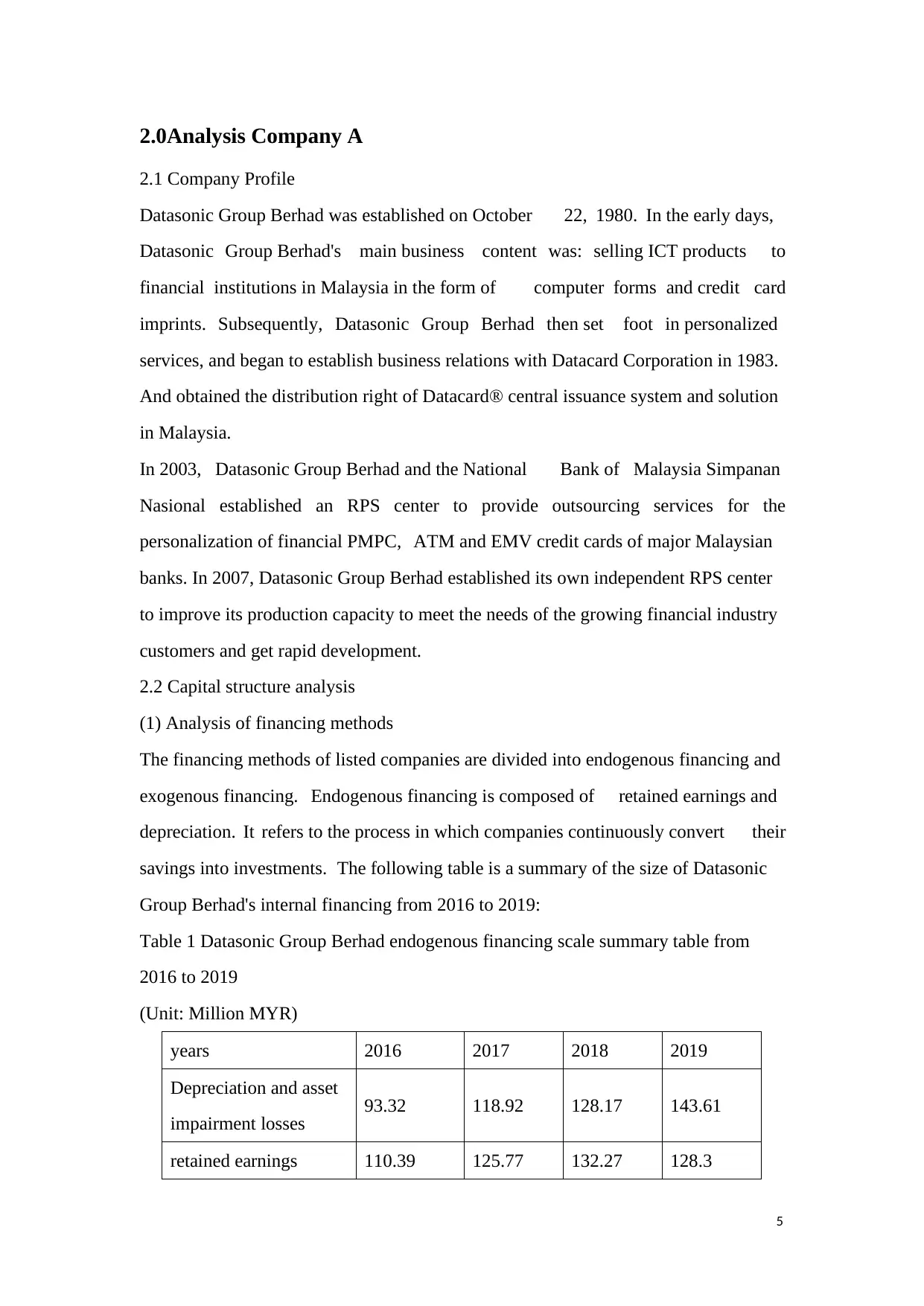
5
2.0Analysis Company A
2.1 Company Profile
Datasonic Group Berhad was established on October 22, 1980. In the early days,
Datasonic Group Berhad's main business content was: selling ICT products to
financial institutions in Malaysia in the form of computer forms and credit card
imprints. Subsequently, Datasonic Group Berhad then set foot in personalized
services, and began to establish business relations with Datacard Corporation in 1983.
And obtained the distribution right of Datacard® central issuance system and solution
in Malaysia.
In 2003, Datasonic Group Berhad and the National Bank of Malaysia Simpanan
Nasional established an RPS center to provide outsourcing services for the
personalization of financial PMPC, ATM and EMV credit cards of major Malaysian
banks. In 2007, Datasonic Group Berhad established its own independent RPS center
to improve its production capacity to meet the needs of the growing financial industry
customers and get rapid development.
2.2 Capital structure analysis
(1) Analysis of financing methods
The financing methods of listed companies are divided into endogenous financing and
exogenous financing. Endogenous financing is composed of retained earnings and
depreciation. It refers to the process in which companies continuously convert their
savings into investments. The following table is a summary of the size of Datasonic
Group Berhad's internal financing from 2016 to 2019:
Table 1 Datasonic Group Berhad endogenous financing scale summary table from
2016 to 2019
(Unit: Million MYR)
years 2016 2017 2018 2019
Depreciation and asset
impairment losses 93.32 118.92 128.17 143.61
retained earnings 110.39 125.77 132.27 128.3
2.0Analysis Company A
2.1 Company Profile
Datasonic Group Berhad was established on October 22, 1980. In the early days,
Datasonic Group Berhad's main business content was: selling ICT products to
financial institutions in Malaysia in the form of computer forms and credit card
imprints. Subsequently, Datasonic Group Berhad then set foot in personalized
services, and began to establish business relations with Datacard Corporation in 1983.
And obtained the distribution right of Datacard® central issuance system and solution
in Malaysia.
In 2003, Datasonic Group Berhad and the National Bank of Malaysia Simpanan
Nasional established an RPS center to provide outsourcing services for the
personalization of financial PMPC, ATM and EMV credit cards of major Malaysian
banks. In 2007, Datasonic Group Berhad established its own independent RPS center
to improve its production capacity to meet the needs of the growing financial industry
customers and get rapid development.
2.2 Capital structure analysis
(1) Analysis of financing methods
The financing methods of listed companies are divided into endogenous financing and
exogenous financing. Endogenous financing is composed of retained earnings and
depreciation. It refers to the process in which companies continuously convert their
savings into investments. The following table is a summary of the size of Datasonic
Group Berhad's internal financing from 2016 to 2019:
Table 1 Datasonic Group Berhad endogenous financing scale summary table from
2016 to 2019
(Unit: Million MYR)
years 2016 2017 2018 2019
Depreciation and asset
impairment losses 93.32 118.92 128.17 143.61
retained earnings 110.39 125.77 132.27 128.3
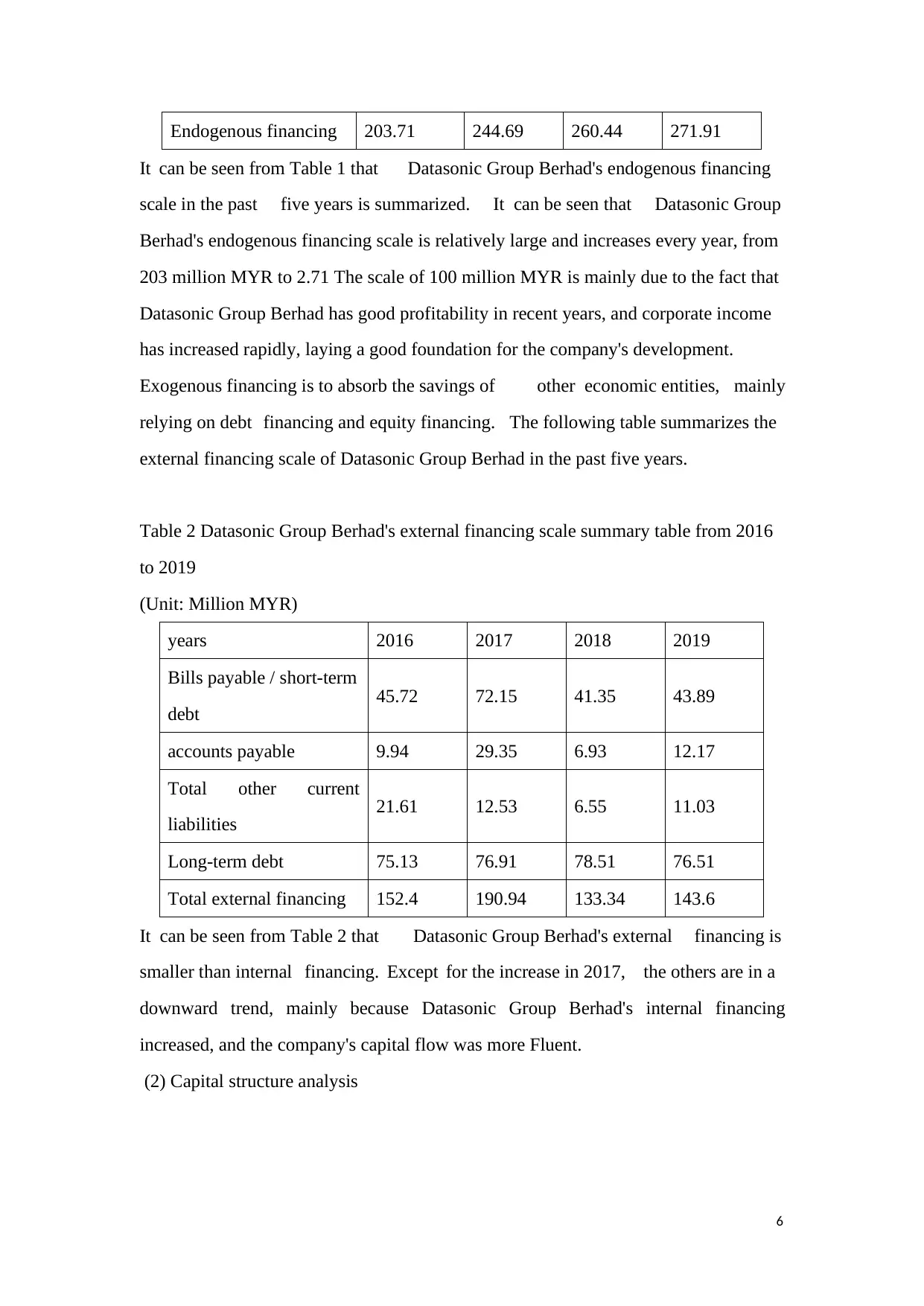
6
Endogenous financing 203.71 244.69 260.44 271.91
It can be seen from Table 1 that Datasonic Group Berhad's endogenous financing
scale in the past five years is summarized. It can be seen that Datasonic Group
Berhad's endogenous financing scale is relatively large and increases every year, from
203 million MYR to 2.71 The scale of 100 million MYR is mainly due to the fact that
Datasonic Group Berhad has good profitability in recent years, and corporate income
has increased rapidly, laying a good foundation for the company's development.
Exogenous financing is to absorb the savings of other economic entities, mainly
relying on debt financing and equity financing. The following table summarizes the
external financing scale of Datasonic Group Berhad in the past five years.
Table 2 Datasonic Group Berhad's external financing scale summary table from 2016
to 2019
(Unit: Million MYR)
years 2016 2017 2018 2019
Bills payable / short-term
debt 45.72 72.15 41.35 43.89
accounts payable 9.94 29.35 6.93 12.17
Total other current
liabilities 21.61 12.53 6.55 11.03
Long-term debt 75.13 76.91 78.51 76.51
Total external financing 152.4 190.94 133.34 143.6
It can be seen from Table 2 that Datasonic Group Berhad's external financing is
smaller than internal financing. Except for the increase in 2017, the others are in a
downward trend, mainly because Datasonic Group Berhad's internal financing
increased, and the company's capital flow was more Fluent.
(2) Capital structure analysis
Endogenous financing 203.71 244.69 260.44 271.91
It can be seen from Table 1 that Datasonic Group Berhad's endogenous financing
scale in the past five years is summarized. It can be seen that Datasonic Group
Berhad's endogenous financing scale is relatively large and increases every year, from
203 million MYR to 2.71 The scale of 100 million MYR is mainly due to the fact that
Datasonic Group Berhad has good profitability in recent years, and corporate income
has increased rapidly, laying a good foundation for the company's development.
Exogenous financing is to absorb the savings of other economic entities, mainly
relying on debt financing and equity financing. The following table summarizes the
external financing scale of Datasonic Group Berhad in the past five years.
Table 2 Datasonic Group Berhad's external financing scale summary table from 2016
to 2019
(Unit: Million MYR)
years 2016 2017 2018 2019
Bills payable / short-term
debt 45.72 72.15 41.35 43.89
accounts payable 9.94 29.35 6.93 12.17
Total other current
liabilities 21.61 12.53 6.55 11.03
Long-term debt 75.13 76.91 78.51 76.51
Total external financing 152.4 190.94 133.34 143.6
It can be seen from Table 2 that Datasonic Group Berhad's external financing is
smaller than internal financing. Except for the increase in 2017, the others are in a
downward trend, mainly because Datasonic Group Berhad's internal financing
increased, and the company's capital flow was more Fluent.
(2) Capital structure analysis

7
The changes in Datasonic Group Berhad ’s asset-liability ratio and shareholder ’s
equity ratio can more comprehensively reflect Datasonic Group Berhad ’s
asset-liability situation.
Table 3 Datasonic Group Berhad's gearing ratio from 2016 to 2019
years 2016 2017 2018 2019
Assets and liabilities(%) 39.41 44.97 40.01 41.15
Shareholders' equity ratio
(%) 60.59 55.03 59.99 58.85
Debt to owner's equity ratio
(%) 65.06 81.73 66.70 69.93
As can be seen from Table 3, Datasonic Group Berhad's asset-liability ratio is
relatively low, basically staying below 45%. Datasonic Group Berhad's asset-liability
ratio has remained volatile in recent years, on the one hand because of changes in
bank loans, On the other hand, due to the improvement of Datasonic Group Berhad's
business capabilities, the scale of commercial credit financing has been reduced, and
the scale of liabilities has remained at a relatively low level, which makes Datasonic
Group Berhad's financing costs and risks lower.
Table 4 summarizes the liability structure of Datasonic Group Berhad in the past five
years. It can be seen that Datasonic Group Berhad ’s liabilities are mainly current
liabilities, which have remained volatile from 2016 to 2019, with a maximum of
62.14% in 2017 and a minimum of 2018 49.29%. This shows that Datasonic Group
Berhad's net cash flow is unstable, and sometimes it needs to rely on a large amount
of short-term debt capital to maintain daily operations.
Table 4 2015 to 2019 Datasonic Group Berhad liability structure change table
years 2016 2017 2018 2019
Current liabilities /
liabilities (%) 52.02 62.14 49.29 55.04
Non-current liabilities /
liabilities (%) 47.98 37.86 50.71 44.96
The changes in Datasonic Group Berhad ’s asset-liability ratio and shareholder ’s
equity ratio can more comprehensively reflect Datasonic Group Berhad ’s
asset-liability situation.
Table 3 Datasonic Group Berhad's gearing ratio from 2016 to 2019
years 2016 2017 2018 2019
Assets and liabilities(%) 39.41 44.97 40.01 41.15
Shareholders' equity ratio
(%) 60.59 55.03 59.99 58.85
Debt to owner's equity ratio
(%) 65.06 81.73 66.70 69.93
As can be seen from Table 3, Datasonic Group Berhad's asset-liability ratio is
relatively low, basically staying below 45%. Datasonic Group Berhad's asset-liability
ratio has remained volatile in recent years, on the one hand because of changes in
bank loans, On the other hand, due to the improvement of Datasonic Group Berhad's
business capabilities, the scale of commercial credit financing has been reduced, and
the scale of liabilities has remained at a relatively low level, which makes Datasonic
Group Berhad's financing costs and risks lower.
Table 4 summarizes the liability structure of Datasonic Group Berhad in the past five
years. It can be seen that Datasonic Group Berhad ’s liabilities are mainly current
liabilities, which have remained volatile from 2016 to 2019, with a maximum of
62.14% in 2017 and a minimum of 2018 49.29%. This shows that Datasonic Group
Berhad's net cash flow is unstable, and sometimes it needs to rely on a large amount
of short-term debt capital to maintain daily operations.
Table 4 2015 to 2019 Datasonic Group Berhad liability structure change table
years 2016 2017 2018 2019
Current liabilities /
liabilities (%) 52.02 62.14 49.29 55.04
Non-current liabilities /
liabilities (%) 47.98 37.86 50.71 44.96
Paraphrase This Document
Need a fresh take? Get an instant paraphrase of this document with our AI Paraphraser
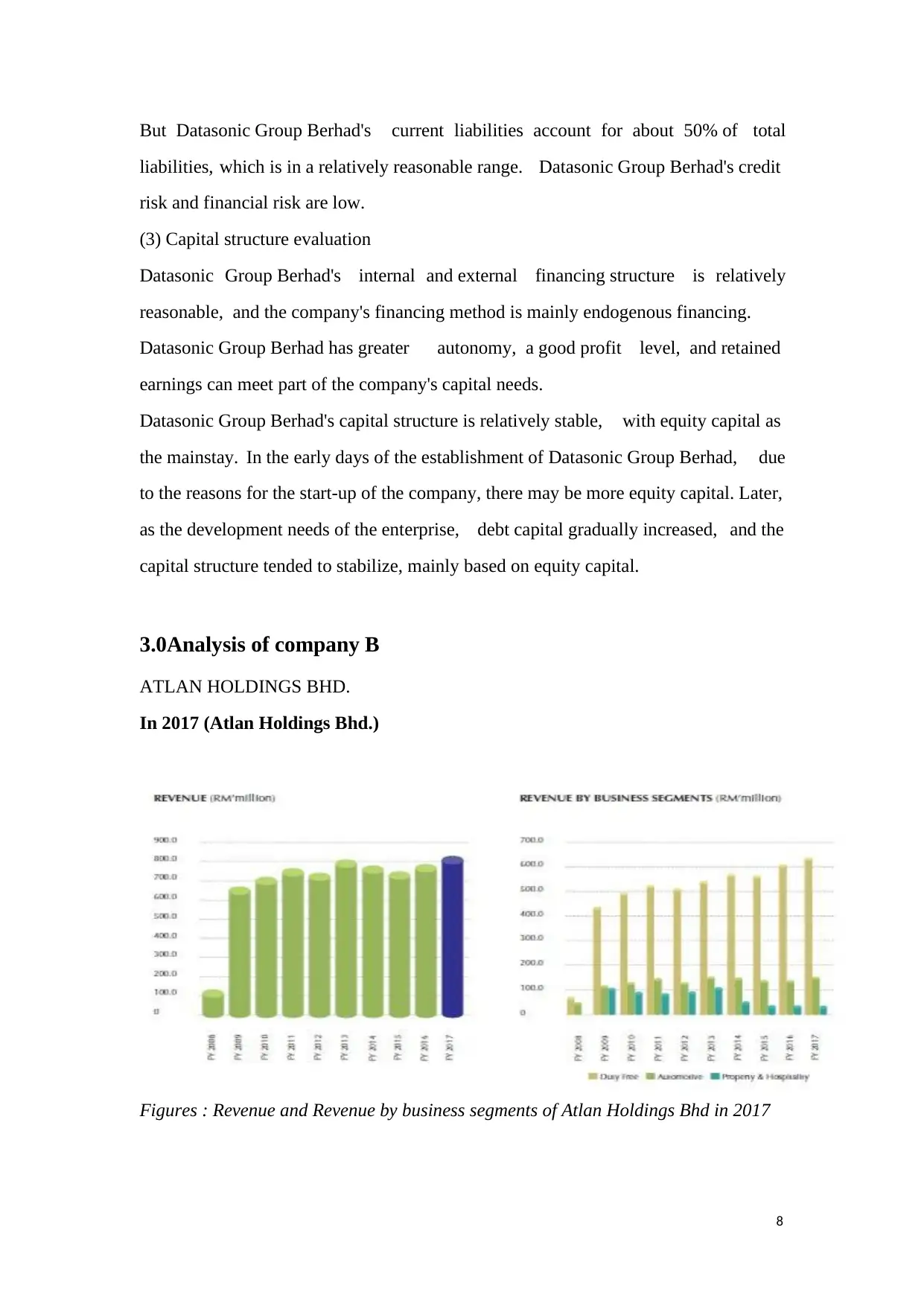
8
But Datasonic Group Berhad's current liabilities account for about 50% of total
liabilities, which is in a relatively reasonable range. Datasonic Group Berhad's credit
risk and financial risk are low.
(3) Capital structure evaluation
Datasonic Group Berhad's internal and external financing structure is relatively
reasonable, and the company's financing method is mainly endogenous financing.
Datasonic Group Berhad has greater autonomy, a good profit level, and retained
earnings can meet part of the company's capital needs.
Datasonic Group Berhad's capital structure is relatively stable, with equity capital as
the mainstay. In the early days of the establishment of Datasonic Group Berhad, due
to the reasons for the start-up of the company, there may be more equity capital. Later,
as the development needs of the enterprise, debt capital gradually increased, and the
capital structure tended to stabilize, mainly based on equity capital.
3.0Analysis of company B
ATLAN HOLDINGS BHD.
In 2017 (Atlan Holdings Bhd.)
Figures : Revenue and Revenue by business segments of Atlan Holdings Bhd in 2017
But Datasonic Group Berhad's current liabilities account for about 50% of total
liabilities, which is in a relatively reasonable range. Datasonic Group Berhad's credit
risk and financial risk are low.
(3) Capital structure evaluation
Datasonic Group Berhad's internal and external financing structure is relatively
reasonable, and the company's financing method is mainly endogenous financing.
Datasonic Group Berhad has greater autonomy, a good profit level, and retained
earnings can meet part of the company's capital needs.
Datasonic Group Berhad's capital structure is relatively stable, with equity capital as
the mainstay. In the early days of the establishment of Datasonic Group Berhad, due
to the reasons for the start-up of the company, there may be more equity capital. Later,
as the development needs of the enterprise, debt capital gradually increased, and the
capital structure tended to stabilize, mainly based on equity capital.
3.0Analysis of company B
ATLAN HOLDINGS BHD.
In 2017 (Atlan Holdings Bhd.)
Figures : Revenue and Revenue by business segments of Atlan Holdings Bhd in 2017

9
The Group posted robust sales of RM809.4 million for the financial year under
examination, hitting 5.4 percent growth for FYE2017 relative to 29 February 2016.
The main sources of financing is from revenue. The main funding source of 78.0 per
cent comes from the duty-free market, with a total revenue of RM631.7 million, a rise
of 4.6 per cent relative to FYE2016. The rise in source of financing was partly
attributed to an increase in selling volume and a rise in prices for other goods, as well
as a contribution from new outlets at Kuala Lumpur International Airport 2. The
automobile market is the second biggest contributor, accounting for a combined sale
of RM147.2 million, an rise of 11.1 per cent relative to FYE2016. For property and
hospitality, the Group posted a total financing of RM28.8 million, marginally lower
compared to FYE2016 due to lower vacancy levels and higher rental prices. The rise
further led to the total foreign exchange income of RM9.0 million. The Group's
financial situation continues to expand with shareholders' assets of RM648.8 million,
capital and bank accounts of RM303.2 million and total cash situation of RM231.0
million. Through retaining a stable financial stance, the Group has lowered its
borrowings to RM72.2 million, its inventories to RM243.7 million and its trade and
other obligations to RM143.2 million. The Company's gross capital obligations,
accepted, contracted for and not contracted for, as at 28 February 2017, increased to
RM6.9 million compared to RM14.2 million) in 2016 for the Group.
The Company shall contain all capital borrowings of the Business within the
aggregate external debt. Gross unpaid liability due and payable over 12 months
consisting of banker's refunds, loan overdrafts, interest owed and the existing part of
financial lease commitments. Capital requires shares attributed to corporate
shareholders and non-controlling interests.
The capital structure of Atlan Holdings Bhd in 2017 is showed as below. Total
external debt plus total equity in 2017 is RM 720.968 million.
The Group posted robust sales of RM809.4 million for the financial year under
examination, hitting 5.4 percent growth for FYE2017 relative to 29 February 2016.
The main sources of financing is from revenue. The main funding source of 78.0 per
cent comes from the duty-free market, with a total revenue of RM631.7 million, a rise
of 4.6 per cent relative to FYE2016. The rise in source of financing was partly
attributed to an increase in selling volume and a rise in prices for other goods, as well
as a contribution from new outlets at Kuala Lumpur International Airport 2. The
automobile market is the second biggest contributor, accounting for a combined sale
of RM147.2 million, an rise of 11.1 per cent relative to FYE2016. For property and
hospitality, the Group posted a total financing of RM28.8 million, marginally lower
compared to FYE2016 due to lower vacancy levels and higher rental prices. The rise
further led to the total foreign exchange income of RM9.0 million. The Group's
financial situation continues to expand with shareholders' assets of RM648.8 million,
capital and bank accounts of RM303.2 million and total cash situation of RM231.0
million. Through retaining a stable financial stance, the Group has lowered its
borrowings to RM72.2 million, its inventories to RM243.7 million and its trade and
other obligations to RM143.2 million. The Company's gross capital obligations,
accepted, contracted for and not contracted for, as at 28 February 2017, increased to
RM6.9 million compared to RM14.2 million) in 2016 for the Group.
The Company shall contain all capital borrowings of the Business within the
aggregate external debt. Gross unpaid liability due and payable over 12 months
consisting of banker's refunds, loan overdrafts, interest owed and the existing part of
financial lease commitments. Capital requires shares attributed to corporate
shareholders and non-controlling interests.
The capital structure of Atlan Holdings Bhd in 2017 is showed as below. Total
external debt plus total equity in 2017 is RM 720.968 million.

10
Figures : Total external debt with total equity in 2017
In 2018 (Atlan Holdings Bhd)
Figures : Revenue and Revenue by business segments of Atlan Holdings Bhd in 2018
The Company generated a high turnover of RM826.3 million for the financial year
under analysis. Revenue is the primary source of funding. The Group's main sales
driver is the duty-free division contributing 74.9 per cent of overall revenue of
RM619.0 million, a small decline of 3.1 per cent relative to the financial year ended
28 February 2017. The decline in sales was mainly due to lower consumer demand,
especially in the first quarter of the financial year ended 28 February 2018. Following
the introduction of the Goods and Services Tax on border outlets and duty-free areas
Figures : Total external debt with total equity in 2017
In 2018 (Atlan Holdings Bhd)
Figures : Revenue and Revenue by business segments of Atlan Holdings Bhd in 2018
The Company generated a high turnover of RM826.3 million for the financial year
under analysis. Revenue is the primary source of funding. The Group's main sales
driver is the duty-free division contributing 74.9 per cent of overall revenue of
RM619.0 million, a small decline of 3.1 per cent relative to the financial year ended
28 February 2017. The decline in sales was mainly due to lower consumer demand,
especially in the first quarter of the financial year ended 28 February 2018. Following
the introduction of the Goods and Services Tax on border outlets and duty-free areas
Secure Best Marks with AI Grader
Need help grading? Try our AI Grader for instant feedback on your assignments.
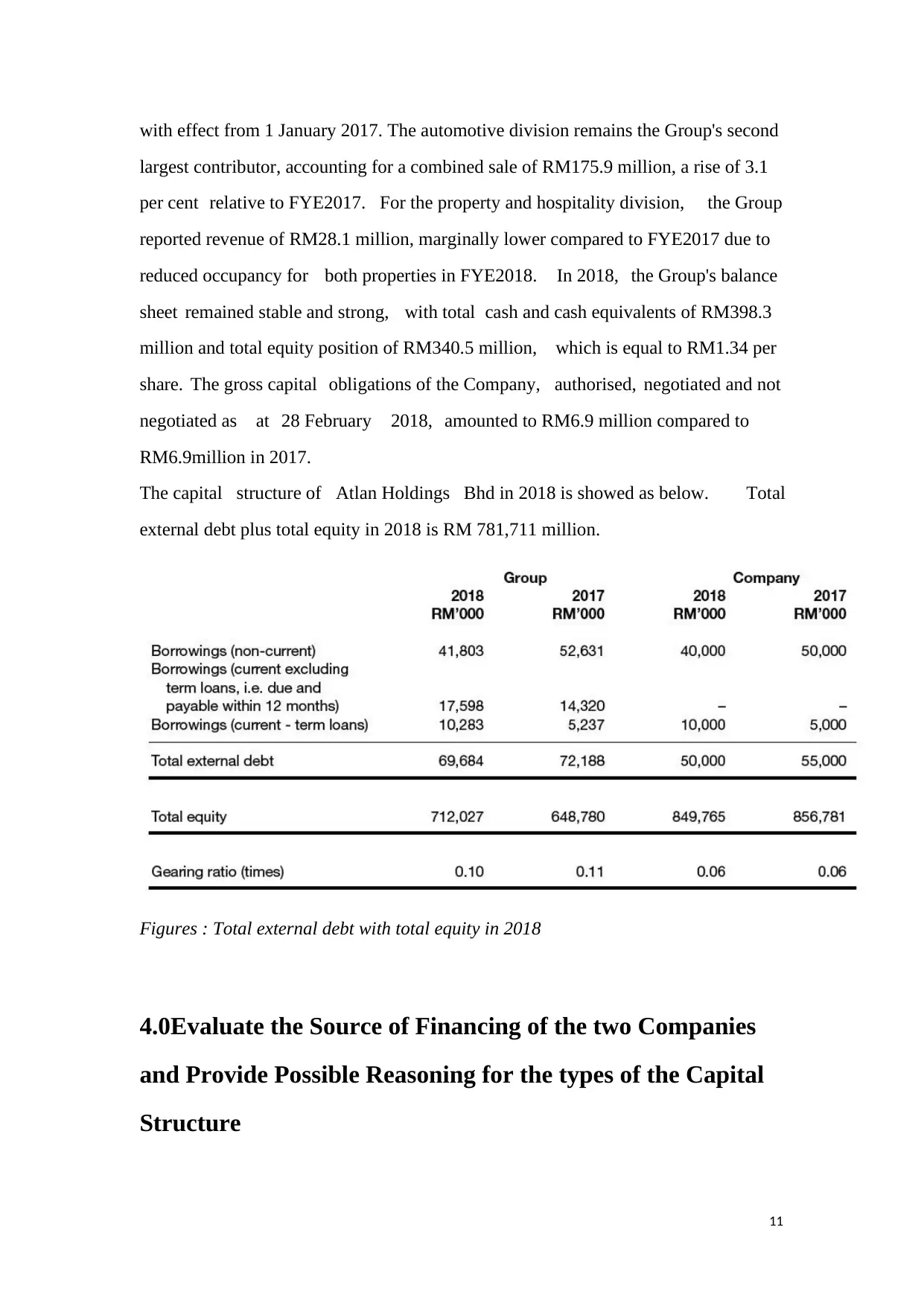
11
with effect from 1 January 2017. The automotive division remains the Group's second
largest contributor, accounting for a combined sale of RM175.9 million, a rise of 3.1
per cent relative to FYE2017. For the property and hospitality division, the Group
reported revenue of RM28.1 million, marginally lower compared to FYE2017 due to
reduced occupancy for both properties in FYE2018. In 2018, the Group's balance
sheet remained stable and strong, with total cash and cash equivalents of RM398.3
million and total equity position of RM340.5 million, which is equal to RM1.34 per
share. The gross capital obligations of the Company, authorised, negotiated and not
negotiated as at 28 February 2018, amounted to RM6.9 million compared to
RM6.9million in 2017.
The capital structure of Atlan Holdings Bhd in 2018 is showed as below. Total
external debt plus total equity in 2018 is RM 781,711 million.
Figures : Total external debt with total equity in 2018
4.0Evaluate the Source of Financing of the two Companies
and Provide Possible Reasoning for the types of the Capital
Structure
with effect from 1 January 2017. The automotive division remains the Group's second
largest contributor, accounting for a combined sale of RM175.9 million, a rise of 3.1
per cent relative to FYE2017. For the property and hospitality division, the Group
reported revenue of RM28.1 million, marginally lower compared to FYE2017 due to
reduced occupancy for both properties in FYE2018. In 2018, the Group's balance
sheet remained stable and strong, with total cash and cash equivalents of RM398.3
million and total equity position of RM340.5 million, which is equal to RM1.34 per
share. The gross capital obligations of the Company, authorised, negotiated and not
negotiated as at 28 February 2018, amounted to RM6.9 million compared to
RM6.9million in 2017.
The capital structure of Atlan Holdings Bhd in 2018 is showed as below. Total
external debt plus total equity in 2018 is RM 781,711 million.
Figures : Total external debt with total equity in 2018
4.0Evaluate the Source of Financing of the two Companies
and Provide Possible Reasoning for the types of the Capital
Structure
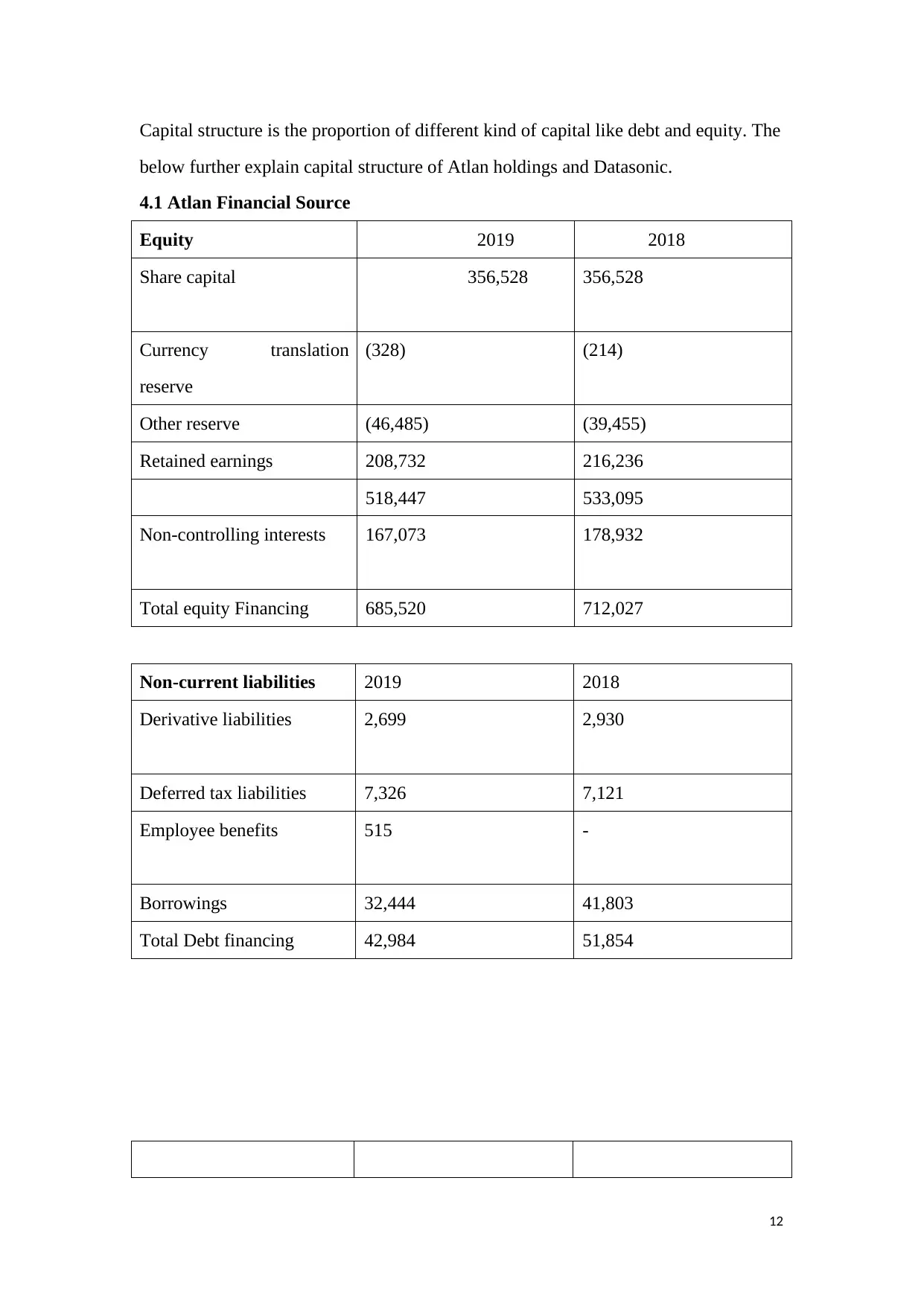
12
Capital structure is the proportion of different kind of capital like debt and equity. The
below further explain capital structure of Atlan holdings and Datasonic.
4.1 Atlan Financial Source
Equity 2019 2018
Share capital 356,528 356,528
Currency translation
reserve
(328) (214)
Other reserve (46,485) (39,455)
Retained earnings 208,732 216,236
518,447 533,095
Non-controlling interests 167,073 178,932
Total equity Financing 685,520 712,027
Non-current liabilities 2019 2018
Derivative liabilities 2,699 2,930
Deferred tax liabilities 7,326 7,121
Employee benefits 515 -
Borrowings 32,444 41,803
Total Debt financing 42,984 51,854
Capital structure is the proportion of different kind of capital like debt and equity. The
below further explain capital structure of Atlan holdings and Datasonic.
4.1 Atlan Financial Source
Equity 2019 2018
Share capital 356,528 356,528
Currency translation
reserve
(328) (214)
Other reserve (46,485) (39,455)
Retained earnings 208,732 216,236
518,447 533,095
Non-controlling interests 167,073 178,932
Total equity Financing 685,520 712,027
Non-current liabilities 2019 2018
Derivative liabilities 2,699 2,930
Deferred tax liabilities 7,326 7,121
Employee benefits 515 -
Borrowings 32,444 41,803
Total Debt financing 42,984 51,854
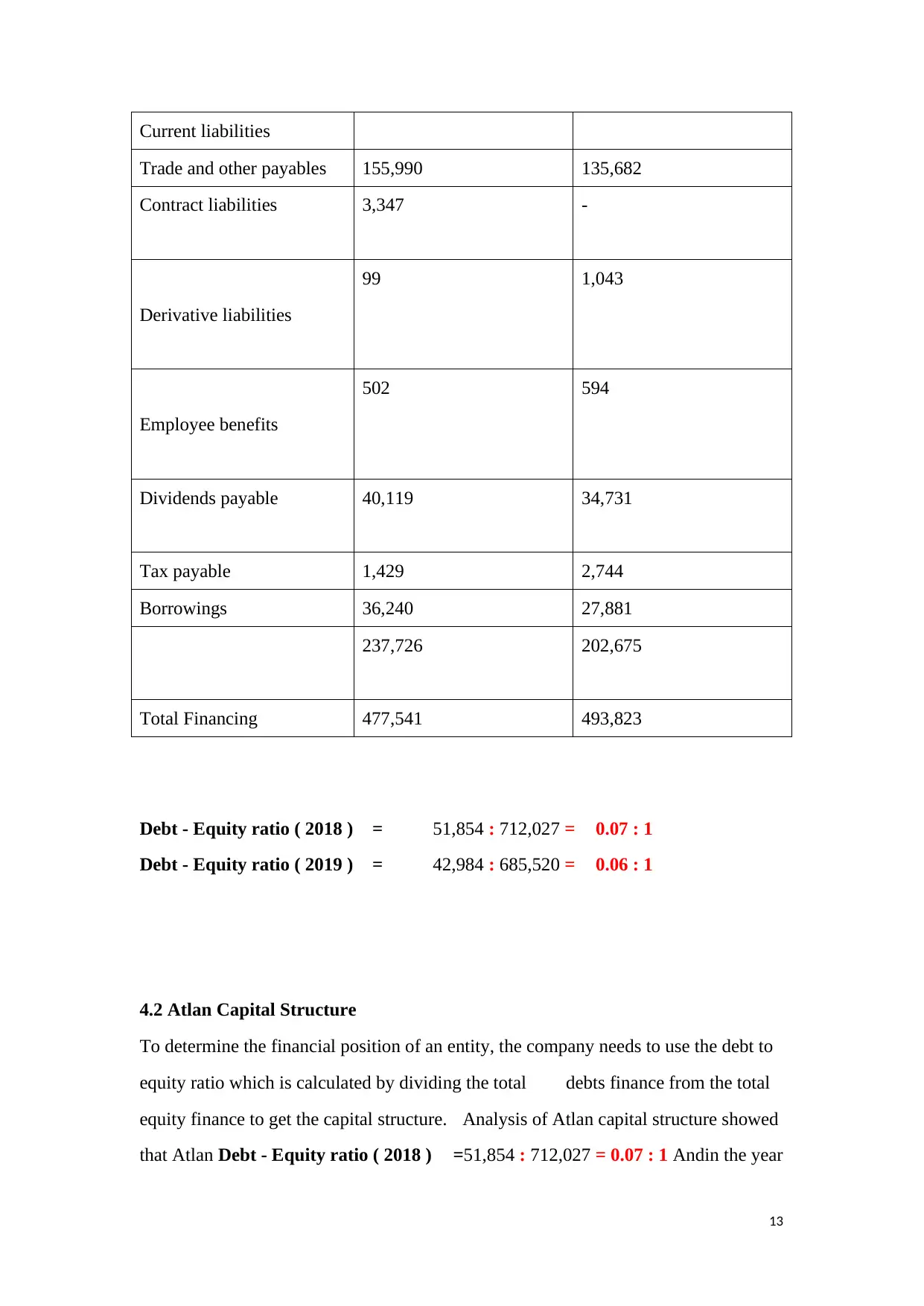
13
Current liabilities
Trade and other payables 155,990 135,682
Contract liabilities 3,347 -
Derivative liabilities
99 1,043
Employee benefits
502 594
Dividends payable 40,119 34,731
Tax payable 1,429 2,744
Borrowings 36,240 27,881
237,726 202,675
Total Financing 477,541 493,823
Debt - Equity ratio ( 2018 ) = 51,854 : 712,027 = 0.07 : 1
Debt - Equity ratio ( 2019 ) = 42,984 : 685,520 = 0.06 : 1
4.2 Atlan Capital Structure
To determine the financial position of an entity, the company needs to use the debt to
equity ratio which is calculated by dividing the total debts finance from the total
equity finance to get the capital structure. Analysis of Atlan capital structure showed
that Atlan Debt - Equity ratio ( 2018 ) =51,854 : 712,027 = 0.07 : 1 Andin the year
Current liabilities
Trade and other payables 155,990 135,682
Contract liabilities 3,347 -
Derivative liabilities
99 1,043
Employee benefits
502 594
Dividends payable 40,119 34,731
Tax payable 1,429 2,744
Borrowings 36,240 27,881
237,726 202,675
Total Financing 477,541 493,823
Debt - Equity ratio ( 2018 ) = 51,854 : 712,027 = 0.07 : 1
Debt - Equity ratio ( 2019 ) = 42,984 : 685,520 = 0.06 : 1
4.2 Atlan Capital Structure
To determine the financial position of an entity, the company needs to use the debt to
equity ratio which is calculated by dividing the total debts finance from the total
equity finance to get the capital structure. Analysis of Atlan capital structure showed
that Atlan Debt - Equity ratio ( 2018 ) =51,854 : 712,027 = 0.07 : 1 Andin the year
Paraphrase This Document
Need a fresh take? Get an instant paraphrase of this document with our AI Paraphraser

14
2019 Atlan Debt - Equity ratio = 42,984 : 685,520 = 0.06 : 1. This showed the
company was able to maintain it financial performance through efficient use of debt
and equity financing (Popescu & Visinescu, 2010).
Datasonic Financial Source
EQUITY Financing 2019 2018
Share capital 135,000 135,000
Merger deficit (11,072) (11,072)
Foreign exchange
translation
reserve
(56) (72)
Retained profits 139,373 143,340
Equity attributable to
owners
of the Company
263,245 267,196
Non-controlling interests (617) (519)
TOTAL EQUITY
Financing
262,628 266,677
NON-CURRENT
LIABILITIES
2019 2018
Long-term borrowings 81,350 90,402
Deferred tax liabilities 2,026 506
Total Debt Financing 83,376 90,908
2019 Atlan Debt - Equity ratio = 42,984 : 685,520 = 0.06 : 1. This showed the
company was able to maintain it financial performance through efficient use of debt
and equity financing (Popescu & Visinescu, 2010).
Datasonic Financial Source
EQUITY Financing 2019 2018
Share capital 135,000 135,000
Merger deficit (11,072) (11,072)
Foreign exchange
translation
reserve
(56) (72)
Retained profits 139,373 143,340
Equity attributable to
owners
of the Company
263,245 267,196
Non-controlling interests (617) (519)
TOTAL EQUITY
Financing
262,628 266,677
NON-CURRENT
LIABILITIES
2019 2018
Long-term borrowings 81,350 90,402
Deferred tax liabilities 2,026 506
Total Debt Financing 83,376 90,908
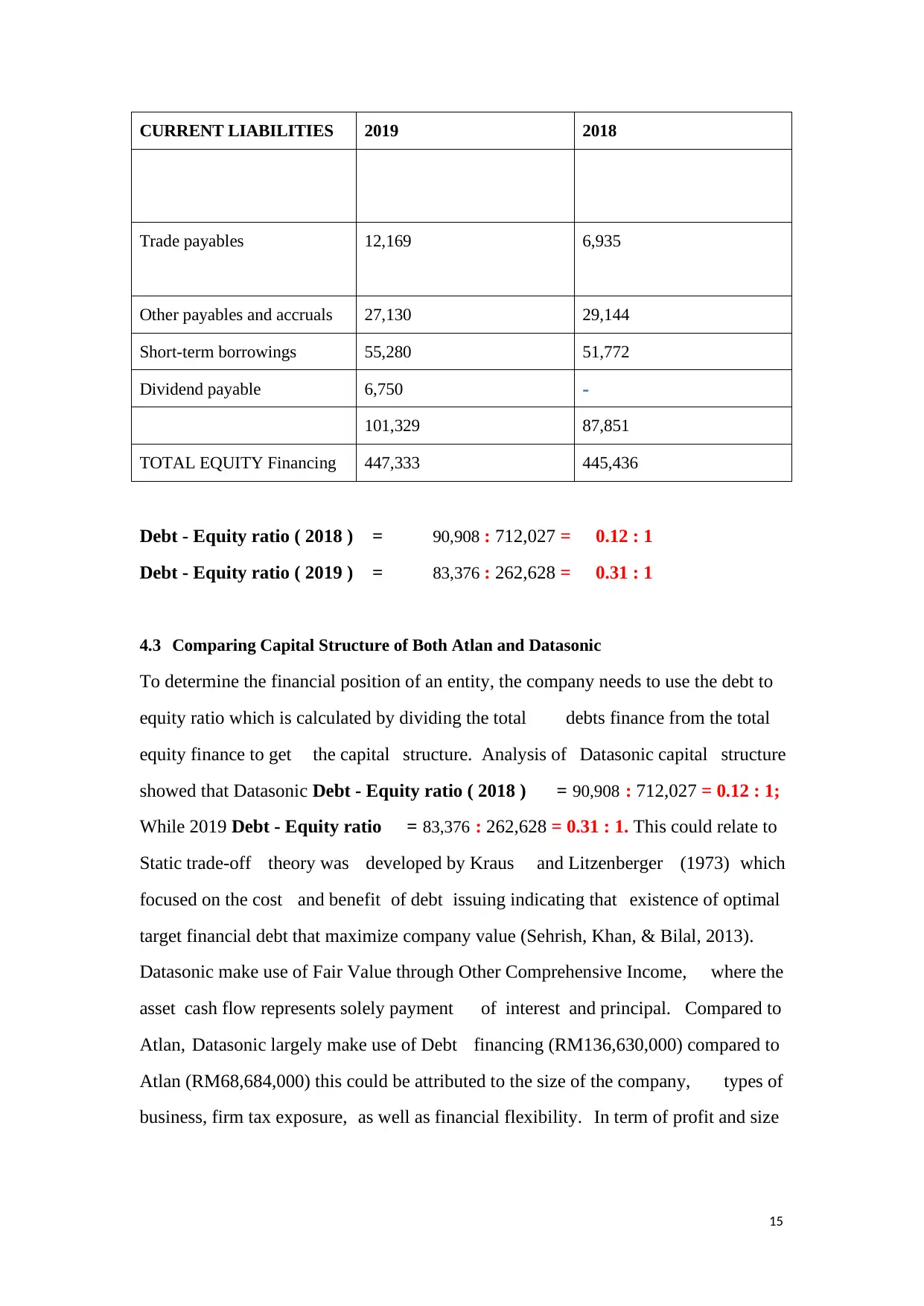
15
CURRENT LIABILITIES 2019 2018
Trade payables 12,169 6,935
Other payables and accruals 27,130 29,144
Short-term borrowings 55,280 51,772
Dividend payable 6,750 -
101,329 87,851
TOTAL EQUITY Financing 447,333 445,436
Debt - Equity ratio ( 2018 ) = 90,908 : 712,027 = 0.12 : 1
Debt - Equity ratio ( 2019 ) = 83,376 : 262,628 = 0.31 : 1
4.3 Comparing Capital Structure of Both Atlan and Datasonic
To determine the financial position of an entity, the company needs to use the debt to
equity ratio which is calculated by dividing the total debts finance from the total
equity finance to get the capital structure. Analysis of Datasonic capital structure
showed that Datasonic Debt - Equity ratio ( 2018 ) = 90,908 : 712,027 = 0.12 : 1;
While 2019 Debt - Equity ratio = 83,376 : 262,628 = 0.31 : 1. This could relate to
Static trade-off theory was developed by Kraus and Litzenberger (1973) which
focused on the cost and benefit of debt issuing indicating that existence of optimal
target financial debt that maximize company value (Sehrish, Khan, & Bilal, 2013).
Datasonic make use of Fair Value through Other Comprehensive Income, where the
asset cash flow represents solely payment of interest and principal. Compared to
Atlan, Datasonic largely make use of Debt financing (RM136,630,000) compared to
Atlan (RM68,684,000) this could be attributed to the size of the company, types of
business, firm tax exposure, as well as financial flexibility. In term of profit and size
CURRENT LIABILITIES 2019 2018
Trade payables 12,169 6,935
Other payables and accruals 27,130 29,144
Short-term borrowings 55,280 51,772
Dividend payable 6,750 -
101,329 87,851
TOTAL EQUITY Financing 447,333 445,436
Debt - Equity ratio ( 2018 ) = 90,908 : 712,027 = 0.12 : 1
Debt - Equity ratio ( 2019 ) = 83,376 : 262,628 = 0.31 : 1
4.3 Comparing Capital Structure of Both Atlan and Datasonic
To determine the financial position of an entity, the company needs to use the debt to
equity ratio which is calculated by dividing the total debts finance from the total
equity finance to get the capital structure. Analysis of Datasonic capital structure
showed that Datasonic Debt - Equity ratio ( 2018 ) = 90,908 : 712,027 = 0.12 : 1;
While 2019 Debt - Equity ratio = 83,376 : 262,628 = 0.31 : 1. This could relate to
Static trade-off theory was developed by Kraus and Litzenberger (1973) which
focused on the cost and benefit of debt issuing indicating that existence of optimal
target financial debt that maximize company value (Sehrish, Khan, & Bilal, 2013).
Datasonic make use of Fair Value through Other Comprehensive Income, where the
asset cash flow represents solely payment of interest and principal. Compared to
Atlan, Datasonic largely make use of Debt financing (RM136,630,000) compared to
Atlan (RM68,684,000) this could be attributed to the size of the company, types of
business, firm tax exposure, as well as financial flexibility. In term of profit and size
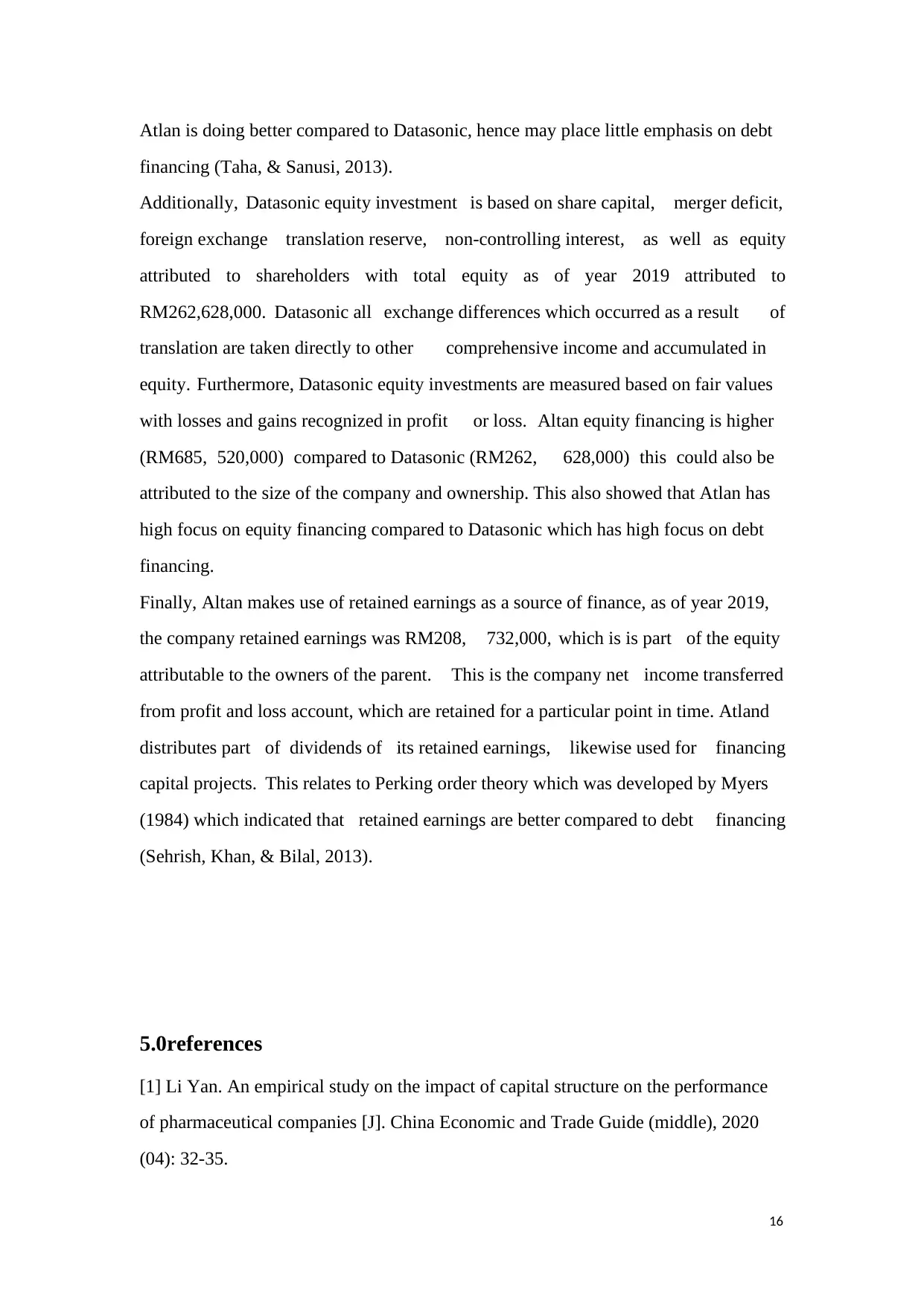
16
Atlan is doing better compared to Datasonic, hence may place little emphasis on debt
financing (Taha, & Sanusi, 2013).
Additionally, Datasonic equity investment is based on share capital, merger deficit,
foreign exchange translation reserve, non-controlling interest, as well as equity
attributed to shareholders with total equity as of year 2019 attributed to
RM262,628,000. Datasonic all exchange differences which occurred as a result of
translation are taken directly to other comprehensive income and accumulated in
equity. Furthermore, Datasonic equity investments are measured based on fair values
with losses and gains recognized in profit or loss. Altan equity financing is higher
(RM685, 520,000) compared to Datasonic (RM262, 628,000) this could also be
attributed to the size of the company and ownership. This also showed that Atlan has
high focus on equity financing compared to Datasonic which has high focus on debt
financing.
Finally, Altan makes use of retained earnings as a source of finance, as of year 2019,
the company retained earnings was RM208, 732,000, which is is part of the equity
attributable to the owners of the parent. This is the company net income transferred
from profit and loss account, which are retained for a particular point in time. Atland
distributes part of dividends of its retained earnings, likewise used for financing
capital projects. This relates to Perking order theory which was developed by Myers
(1984) which indicated that retained earnings are better compared to debt financing
(Sehrish, Khan, & Bilal, 2013).
5.0references
[1] Li Yan. An empirical study on the impact of capital structure on the performance
of pharmaceutical companies [J]. China Economic and Trade Guide (middle), 2020
(04): 32-35.
Atlan is doing better compared to Datasonic, hence may place little emphasis on debt
financing (Taha, & Sanusi, 2013).
Additionally, Datasonic equity investment is based on share capital, merger deficit,
foreign exchange translation reserve, non-controlling interest, as well as equity
attributed to shareholders with total equity as of year 2019 attributed to
RM262,628,000. Datasonic all exchange differences which occurred as a result of
translation are taken directly to other comprehensive income and accumulated in
equity. Furthermore, Datasonic equity investments are measured based on fair values
with losses and gains recognized in profit or loss. Altan equity financing is higher
(RM685, 520,000) compared to Datasonic (RM262, 628,000) this could also be
attributed to the size of the company and ownership. This also showed that Atlan has
high focus on equity financing compared to Datasonic which has high focus on debt
financing.
Finally, Altan makes use of retained earnings as a source of finance, as of year 2019,
the company retained earnings was RM208, 732,000, which is is part of the equity
attributable to the owners of the parent. This is the company net income transferred
from profit and loss account, which are retained for a particular point in time. Atland
distributes part of dividends of its retained earnings, likewise used for financing
capital projects. This relates to Perking order theory which was developed by Myers
(1984) which indicated that retained earnings are better compared to debt financing
(Sehrish, Khan, & Bilal, 2013).
5.0references
[1] Li Yan. An empirical study on the impact of capital structure on the performance
of pharmaceutical companies [J]. China Economic and Trade Guide (middle), 2020
(04): 32-35.
Secure Best Marks with AI Grader
Need help grading? Try our AI Grader for instant feedback on your assignments.
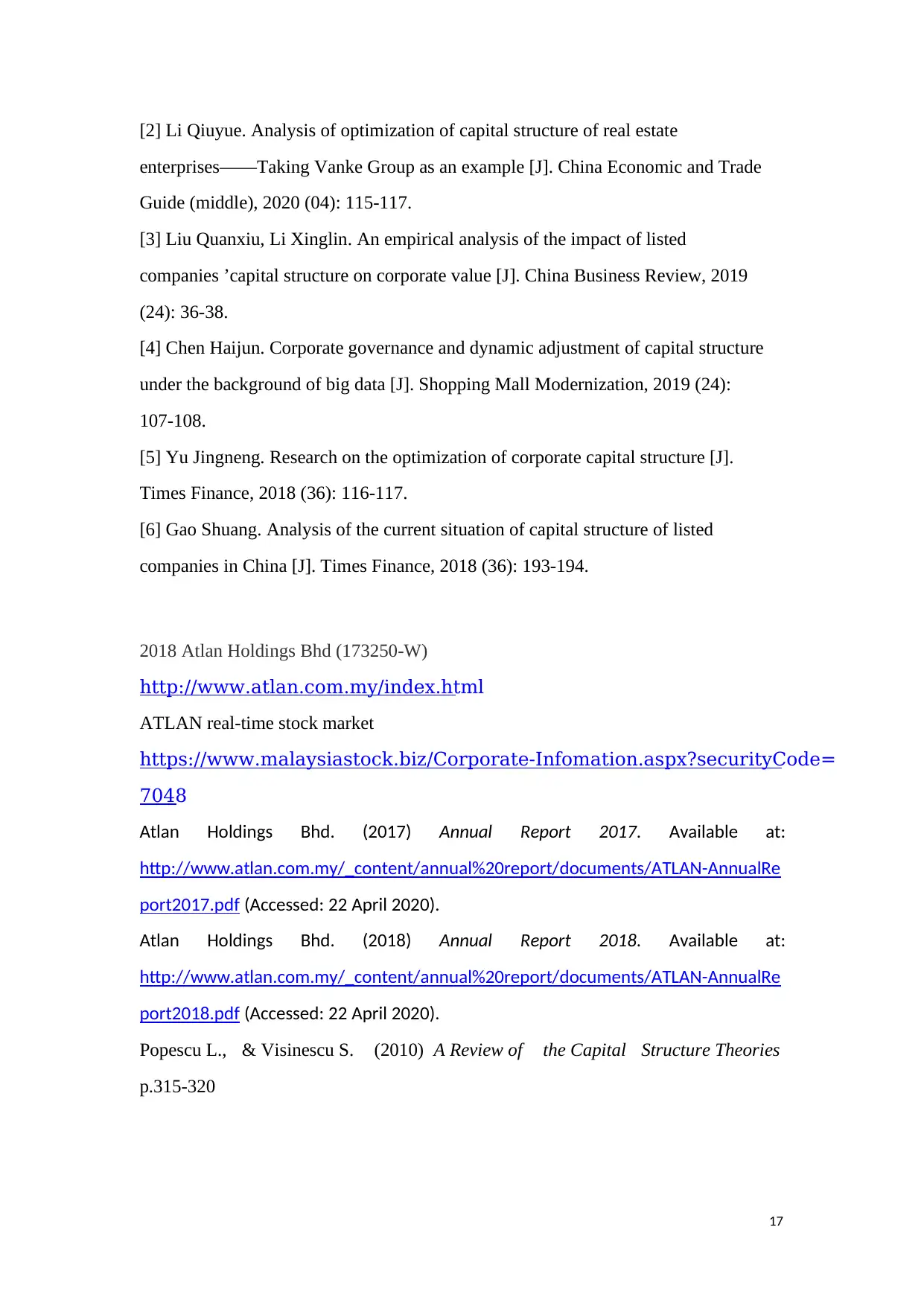
17
[2] Li Qiuyue. Analysis of optimization of capital structure of real estate
enterprises——Taking Vanke Group as an example [J]. China Economic and Trade
Guide (middle), 2020 (04): 115-117.
[3] Liu Quanxiu, Li Xinglin. An empirical analysis of the impact of listed
companies ’capital structure on corporate value [J]. China Business Review, 2019
(24): 36-38.
[4] Chen Haijun. Corporate governance and dynamic adjustment of capital structure
under the background of big data [J]. Shopping Mall Modernization, 2019 (24):
107-108.
[5] Yu Jingneng. Research on the optimization of corporate capital structure [J].
Times Finance, 2018 (36): 116-117.
[6] Gao Shuang. Analysis of the current situation of capital structure of listed
companies in China [J]. Times Finance, 2018 (36): 193-194.
2018 Atlan Holdings Bhd (173250-W)
http://www.atlan.com.my/index.html
ATLAN real-time stock market
https://www.malaysiastock.biz/Corporate-Infomation.aspx?securityCode=
7048
Atlan Holdings Bhd. (2017) Annual Report 2017. Available at:
http://www.atlan.com.my/_content/annual%20report/documents/ATLAN-AnnualRe
port2017.pdf (Accessed: 22 April 2020).
Atlan Holdings Bhd. (2018) Annual Report 2018. Available at:
http://www.atlan.com.my/_content/annual%20report/documents/ATLAN-AnnualRe
port2018.pdf (Accessed: 22 April 2020).
Popescu L., & Visinescu S. (2010) A Review of the Capital Structure Theories
p.315-320
[2] Li Qiuyue. Analysis of optimization of capital structure of real estate
enterprises——Taking Vanke Group as an example [J]. China Economic and Trade
Guide (middle), 2020 (04): 115-117.
[3] Liu Quanxiu, Li Xinglin. An empirical analysis of the impact of listed
companies ’capital structure on corporate value [J]. China Business Review, 2019
(24): 36-38.
[4] Chen Haijun. Corporate governance and dynamic adjustment of capital structure
under the background of big data [J]. Shopping Mall Modernization, 2019 (24):
107-108.
[5] Yu Jingneng. Research on the optimization of corporate capital structure [J].
Times Finance, 2018 (36): 116-117.
[6] Gao Shuang. Analysis of the current situation of capital structure of listed
companies in China [J]. Times Finance, 2018 (36): 193-194.
2018 Atlan Holdings Bhd (173250-W)
http://www.atlan.com.my/index.html
ATLAN real-time stock market
https://www.malaysiastock.biz/Corporate-Infomation.aspx?securityCode=
7048
Atlan Holdings Bhd. (2017) Annual Report 2017. Available at:
http://www.atlan.com.my/_content/annual%20report/documents/ATLAN-AnnualRe
port2017.pdf (Accessed: 22 April 2020).
Atlan Holdings Bhd. (2018) Annual Report 2018. Available at:
http://www.atlan.com.my/_content/annual%20report/documents/ATLAN-AnnualRe
port2018.pdf (Accessed: 22 April 2020).
Popescu L., & Visinescu S. (2010) A Review of the Capital Structure Theories
p.315-320
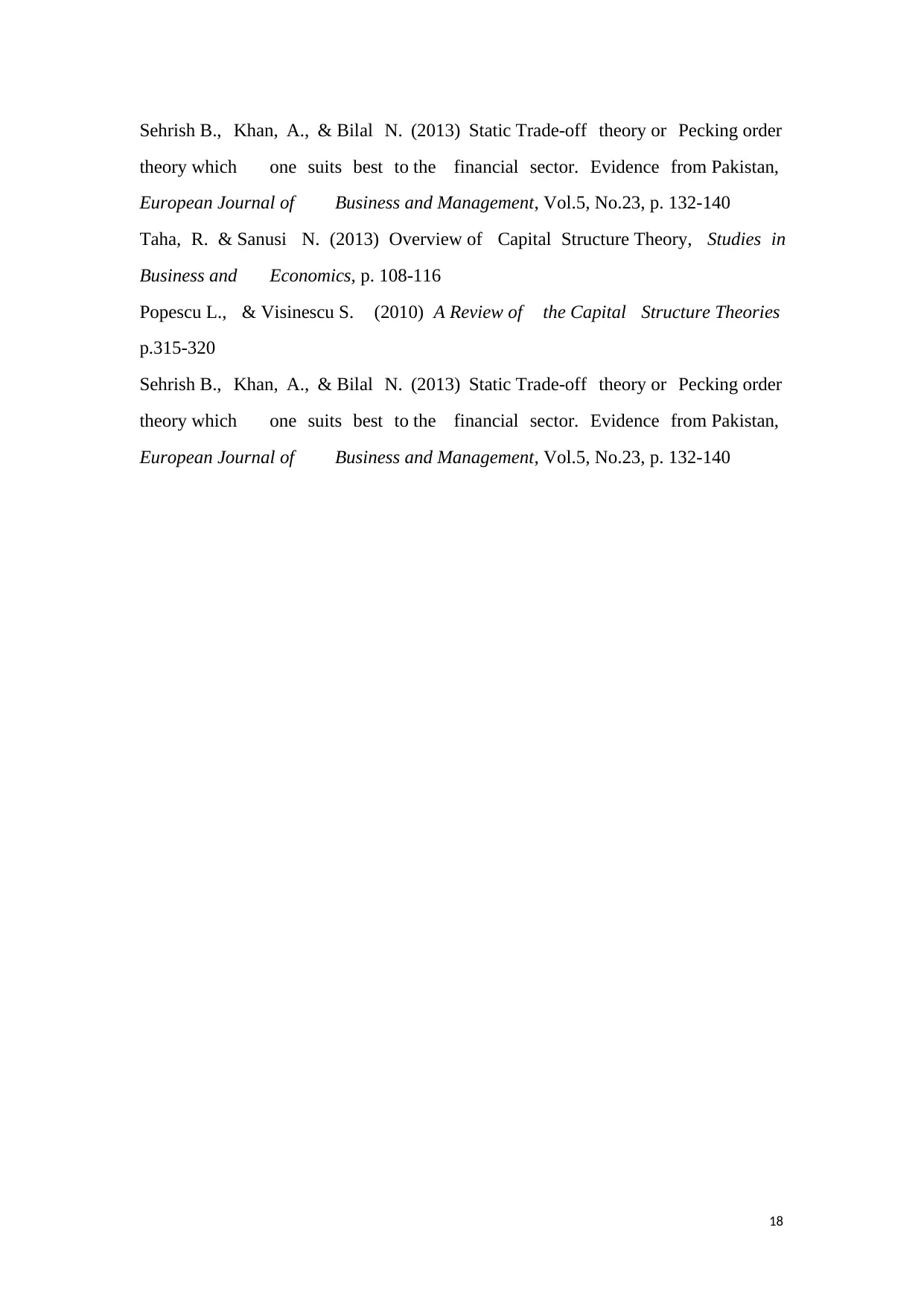
18
Sehrish B., Khan, A., & Bilal N. (2013) Static Trade-off theory or Pecking order
theory which one suits best to the financial sector. Evidence from Pakistan,
European Journal of Business and Management, Vol.5, No.23, p. 132-140
Taha, R. & Sanusi N. (2013) Overview of Capital Structure Theory, Studies in
Business and Economics, p. 108-116
Popescu L., & Visinescu S. (2010) A Review of the Capital Structure Theories
p.315-320
Sehrish B., Khan, A., & Bilal N. (2013) Static Trade-off theory or Pecking order
theory which one suits best to the financial sector. Evidence from Pakistan,
European Journal of Business and Management, Vol.5, No.23, p. 132-140
Sehrish B., Khan, A., & Bilal N. (2013) Static Trade-off theory or Pecking order
theory which one suits best to the financial sector. Evidence from Pakistan,
European Journal of Business and Management, Vol.5, No.23, p. 132-140
Taha, R. & Sanusi N. (2013) Overview of Capital Structure Theory, Studies in
Business and Economics, p. 108-116
Popescu L., & Visinescu S. (2010) A Review of the Capital Structure Theories
p.315-320
Sehrish B., Khan, A., & Bilal N. (2013) Static Trade-off theory or Pecking order
theory which one suits best to the financial sector. Evidence from Pakistan,
European Journal of Business and Management, Vol.5, No.23, p. 132-140
1 out of 18
Related Documents
Your All-in-One AI-Powered Toolkit for Academic Success.
+13062052269
info@desklib.com
Available 24*7 on WhatsApp / Email
![[object Object]](/_next/static/media/star-bottom.7253800d.svg)
Unlock your academic potential
© 2024 | Zucol Services PVT LTD | All rights reserved.
